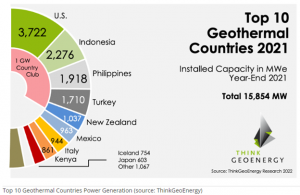What is Geothermal?
The word geothermal literally means “Earth heat”.[1] Geothermal technology uses the heat from steam and hot water stored deep within the earth to create geothermal energy, which can be harnessed both as a source of renewable electricity, as well as directly for heating and cooling applications.
If geothermal reservoirs are close enough to the surface, they can be tapped by drilling wells, sometimes over two miles deep. Hot water and steam shoot up the wells naturally or are pumped to the surface, where, at temperatures between 250-700°F, they are used to generate electricity in geothermal power plants. Shallower reservoirs of lower temperatures between 70-300°F are used directly in health spas, greenhouses, fish farms, industry and in residential and commercial space heating systems.[2] Geothermal heat pumps use the constant temperatures near the surface of the earth to heat and cool buildings by transferring heat from the ground (or water) into buildings during the winter and reversing the process in the summer.[3]
The chart presented below identifies the top 10 geothermal producing countries, based on installed generation capacity in terms of MWe – amount of electricity generated in megawatt hours (MWh). The U.S. leads the world in geothermal electricity generated.

Source: ThinkGeoEnergy Research[4]
In 2021, there were geothermal power plants in seven U.S. states (California, Nevada, Utah, Oregon, Hawaii, Idaho, New Mexico), producing about 16 billion kWh, equal to 0.4% of total U.S. utility-scale electricity generation.[5] This is only a fraction of the U.S. geothermal potential, as many technical barriers constrain industry growth. The U.S. Department of Energy’s (DOE) Geothermal Technologies Office (GTO) supports the development of geothermal technologies, and is focused on what’s required now and over the next two decades to promote deployment of geothermal systems.
Updated June 2022 by Diane M Long

Comments are closed.